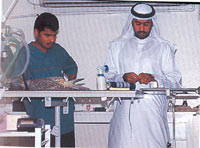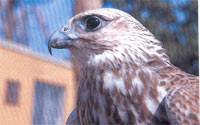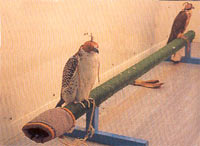|
Falconry is an ancient sport that
has been practiced all over Europe and the Middle East
since the 8th Century. Descriptions of hunting houbara
with falcons in Arabia more than 700 years ago exist in
the chronicles of the legendary Ousama (translation by
Potter, 1929).
In Arabia it was practiced not so
much as a sport but as a means to provide the tribe's
meager diet with some very necessary protein. The birds
that were hunted with the falcons were the Bustard (houbara,
Chlamydotis undulata) and the Stone curlew (karawan,
Burhinus oedicnemus). The houbara with a weight of two
or three kilograms, was large enough to provide food for
several people. It has a surprisingly powerful flight
and is an able match for many falcons. It migrates in
the autumn from the northern hemisphere to Arabia and
Africa to over-winter. The Bedouin captured the falcons,
both peregrine (Falco peregrinus) and saker (Falco
cherrug), on their passage to Africa.
There were numerous ways to trap the
falcons, depending on the availability of materials. The
most ingenious method was very simple. If in the first
light of dawn a bedu located a falcon sitting on a dune,
he would return to the same location the following
morning, riding together with a friend on a single
camel. As soon as they found the bird again, they would
ride upwind from the falcon and dismount, keeping the
camel between themselves and the bird of prey. Hidden
behind the camel one bedu would bury the other in the
sand, leaving only his head and arms exposed and further
concealing him with some brush of a desert bush. He
would then remount and ride away, whilst at the same
time the man left behind in the sand would release a
pigeon that was tethered by the legs with a string. The
falcon, not realizing that a man had been left behind,
would assume that the fluttering pigeon had been
disturbed by the departing camel and would attack the
bird as soon as the camel and its rider were some
distance away. It would dive upon and kill the pigeon
upwind from the buried hunter. As the pigeon was
attached by a string, the falcon could not carry it away
and would settle down to start easting the dead bird.
Falcons do not like the wind ruffling their feathers, so
whilst eating the bird would always face into the wind,
turning its back on the buried bedu who was down-wind
from the falcon. Pulling the string slowly towards him
the hunter would bring the dead pigeon, with the falcon
sitting on top, closer to his outstretched arm. Because
of the movement the falcon, thinking the pigeon was
still alive, would keep attacking it fiercely until the
moment when the hunter cold grab its legs and throw a
cloth over the bird.

Another way to trap falcons was
based purely on the fact that the bedu understood the
behaviour of falcons, due to his considerable power of
observation. Knowing that falcons are very opportunistic
feeders and therefore will use any means to catch an
easy prey, the falconer would use a smaller falcon, the
kestrel (Falco tinnunculus), to trick the bird he wanted
to catch. Kestrels are resident breeders in the UAE and
are the smallest and most defenseless falcons of the
region. Once the large peregrines and sakers started to
arrive in the autumn, the hunter waited in a hide with
his kestrel outside, tied to a block. Attached to the
kestrel's legs was a bundle of feathers that was laced
with very fine snares. The kestrel with its very keen
eyesight would spot an approaching large falcon long
before the falconer could see it. As soon as the
falconer noticed that his kestrel started to become
agitated, he would release it. The kestrel, irritated by
the bundle of feathers tied to its legs, would
immediately start flying. The large falcon would see it
and mistake the bundle of feathers for a freshly killed
prey and would immediately try to rob the kestrel.
Stooping at the kestrel, it would pass underneath the
latter and, turning on its back in mid-air, would try to
sink its talons into the feather bundle under the
fleeing bird. Thus he would become entangled in the
snares. Now attached to each other, both falcon and
kestrel would be unable to fly and would finally come
down in a fluttering tangle of wings to the ground where
the waiting bedu would throw a cloth over the struggling
pair.
Along the UAE coastline and on the
offshore islands, falconers installed more complicated
traps, using nets that were flicked over a falcon by a
man sitting in a hide. The hunter would have to sit in
the hide patiently and motionless, sometimes for days on
end.
Once the falconers managed to trap
the valuable birds, they had only two or three weeks to
train them before the migrating houbaras started to
arrive. The falcon's eyes were closed by threading a
hair from a horse's tail through the lower eyelids,
bringing it together and tying them in a know on top of
its head. The falcon's eyes were thus permanently shut
and stayed like this for several days during which the
falconer kept the bird with him for 24 hours of the day.
He carried the bird with him wherever he went, stroked
it, talked to it and called it by its chosen name. This
was to calm the wild bird and to make it used to the
falconer's voice and to sitting on the falconer's glove
(the mangalah). When the hair thread was removed after
about three days, the first thing the falcon would see
was the man whose voice he had heard and started to
trust during his days of temporary blindness. The
falconer also offered his bird some food from his hand
and in this way the bond of trust between a wild
captured bird and a falconer was established over a
relatively short period of time.

Shortly thereafter the bird, whilst
still attached to the glove with a long string, would be
"cast off" the mangalah to fly a few meters to some food
that was offered to him. The flight distance was
constantly increased and eventually the bird was left to
fly free. The bird was also introduced to the lure,
which was made from a pair of houbara wings, retained
from the previous year. In this way the falcon, which
would not necessarily kill bustards in the wild, or
which might come from a region where there were no
houbaras, would become familiar with the quarry that the
bedouin wished it to hunt.
The bedu would hunt the bustards
with his falcon throughout the winter months. In the
early morning they would search for houbara tracks in
the sand, which they then followed, knowing that this
night-active bird would spend the day resting under a
bush. Once a houbara was found and "brought up", the
falcon was released to hopefully capture and kill it.
After a successful hunt the falconer would feed his bird
with the head and the neck of the bustard and keep the
rest for himself and his family. In spring, when the
houbaras returned to their breeding grounds, there was
no prey small enough for the falcon to kill and at the
same time large enough to feed the falconer and his
bird. That was the time when the bedouin would take
their hunting companions and set them free again, hoping
that the coming autumn would give them new birds to
train and to hunt with.

Much has changed since the days when
falconry was a mean to improve living conditions.
Nowadays falconry is practiced only as a sport.
Falconers have started to experiment with different
breeds of falcons to find one that would be stronger and
faster than the usual saker and peregrine. It turned out
that hybrid birds of the large white Gyr falcon and the
saker answered this need. The Gyr falcon originates from
the far north of North America, and it is therefore not
surprising that at first there were many problems with
keeping and breeding these falcons in the Arabian
deserts. Air-conditioning and cross-breeding have helped
solve some of the problems. In the last thirty years
several falcon hospitals have been started to treat the
diseases that occur with both, wild-caught and
captivity-bred birds.

I have visited the two falcon
hospitals, one in Dubai and the other in Abu Dhabi. They
all seem to be perpetually busy, with waiting rooms
thronged with men holding their birds on their wrist.
Several veterinary specialists treat the various
diseases, of which bumble foot and aspergillosus are
some of the most common. In bumble foot a severe
infection of the area between the toes of the bird
become infected, usually because the perch on which the
bird is kept does not allow for proper circulation of
blood in the tissues of the foot. It is cured with both
surgery and antibiotics. Aspergillosus is a fungal
infection that attacks the respiratory tract, especially
the air sacs that are situated beyond the spongy lungs.
Broken feathers are treated with implants (glued into
the remnant of the old feather with superglue!), and
most birds are fitted with a microchip, that will enable
owners and veterinaries to recognize specific birds.
Even though in the Emirates falconry
is still practiced along traditional lines, the
efficiency of modern transport, communications and
weapons has increased the hunting pressure on the prey
animals. Combined with habitat degradation of the
breeding grounds and illegal trapping along the
migration routes, it has resulted in the decline in
numbers of the houbara.
There is also concern for the
falcons, as the birds are expensive and a strong illegal
trade is thriving all over the Middle East.
In September 1989 the National Avian
Research Centre (NARC) was started in Abu Dhabi with its
goal being the captive breeding of both, houbara and
falcons in order to reduce the pressure on wild stocks.
The organization also does ecological research to
promote the knowledge and understanding of avian
conservation. The ultimate goal is to achieve
sustainable hunting and to provide sufficient houbara as
a quarry resource for falconry. Several times in the
past years captive bred falcons or falcons that had been
used for hunting were released in Pakistan by the Sheikh
Zayed Falcon Release Program in cooperation with the
Worldwide Fund for Nature (Pakistan). In 1995 over 100
falcons were released and in 1996 a total of 85 falcons
(a.o. 60 sakers and 20 peregrines) flew to freedom in
the Gilgit area of northern Pakistan. Although flacons
were always released at the end of the hunting season,
this was never before done under scientific monitoring.
In the NARC release program, each falcon is fitted with
rings and microchips so that there is a chance of
identifying the bird wherever it may be captured. A
small number of birds were also fitted with satellite
transmitters, which allowed their movements to be
tracked. In this way, birds have been tracked into
western China and southern Russia and back into
Kazakhstan on their southward migration.
Besides the well-known saker and
peregrine falcons, which are mainly used for hunting,
there are several other species of falcons that occur in
the UAE. One of the two species that breed here
occasionally is the already mentioned kestrel (Falco
tinnunculus). The other one is the small Barbary falcon
(Falco pelegrinoides). Both birds are often captured and
sold in the suqs, a practice that is highly dangerous
for the birds and threatens their continued existence in
this region. Other falcons that visit the region in
small numbers are the Hobby (Falco subbuteo), most
commonly seen in the fall and the Sooty falcon (Falco
concolor) that is a summer breeder on some of the rocky
Arabian Gulf islands. The Lanner falcon (Falco biarmicus)
and the Barbary falcon are often seen with tresses still
attached to their feet, indicating that they are escaped
captive birds. Only rarely does a wild bird visit this
region. Of all these falcons only the Sooty falcon has
been the subject of extensive surveys as well as of a
documentary film by local cineaste Yusuf Thakur, who
filmed the birds on one of the off-shore islands of a
neighbouring Gulf country
Hunting with falcons is a very
special experience - best described by one of the poems
of the Presiedent HH Sheikh Zayed bin Sultan al Nahyan:
"O bird, I trained you to hunt,
to hunt the bustard for me
a bird that is fierce on the run (....)
Let the bustard which fly as fast as the wind fly away
and return
I am sure you'll be filled with pride upon hunting them
(....)
Each kinsman and friend tells a tale of a falcon.
Upon their return in their fast-running cars,
Falconers bring bustard and tell stories about them."
Although visitors to the UAE are not
very likely to witness a beduin falcon hunt, it is
possible to see them fly their birds during training.
There are several sites around Dubai where falcons are
being flown every day of the early winter. Also, there
are now several travel organisations and hotels, which
put on special falcon shows that are popular with young
and old alike.
The training is mostly done with the
lure made of houbara wings. This is usually spun around
in circles by the falconer, though recently kites have
been used to move the lure into the air. The falcon is
let free to fly off, where it either settles on a high
perch of a tree or bush, or flies high to find potential
prey. When the falconer swings the lure, he tried to
make the circles erratic in both height and path, so
that the falcon has to make an effort to catch it. Often
several passes are needed before the falcon catches its
prey. When it does, it is rewarded by the falconer with
sweet words and a mouthful of meat. This close
interaction between the falconer and his bird is
necessary to maintain the bond of trust that makes the
bird com back to the falconer even though he is free to
fly away and never return. It is this interaction that
takes place between a falcon and its handler that is one
of the most fascinating between a wild animal and man.
|
